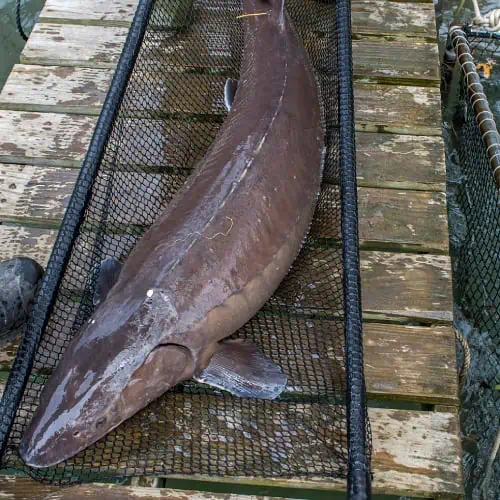
One of the oldest groups of animals to have evolved into complex forms, fish have been around for hundreds of millions of years. They were some of the first vertebrates to roam the oceans and successfully occupy inland areas via estuaries, rivers, and streams. Over millennia, they continued to evolve more specialized structures, resulting in species that are markedly different compared to their ancestors.
Despite the presence of modern types of fish, there remains to be more than a handful of species possessing primitive features. Many of these are called “living fossils” as they closely resemble their extinct counterparts. They have forms that are truly remarkable, earning them a reputation as monsters of the rivers and seas. Despite the armored bodies, impressive sizes, and frighteningly numerous teeth of some of these prehistoric fish, they are seldom associated with causing harm.
A major reason why some of these fish have seemed to bypass evolutionary trends is that their early adaptations proved to be extremely effective at keeping them alive. It’s wrong to believe, however, that these species existed right alongside their prehistoric ancestors. Rather, they are the products of years of evolution that have fine-tuned their DNA, creating a near-perfect code for survival.
1) Sturgeon (Acipenseridae)
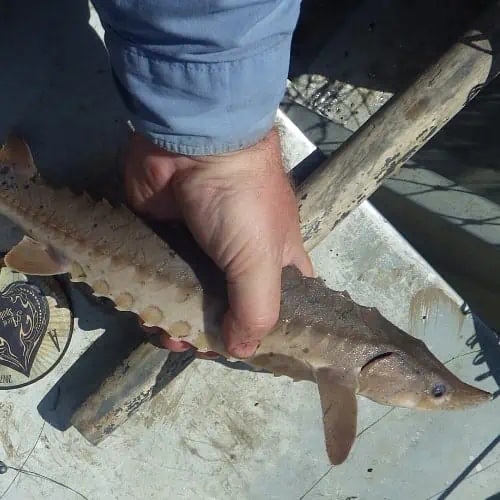
Descended from the prehistoric acipenseriforms, which first appeared during the early Jurassic period, today’s sturgeons are some of the most remarkable freshwater species in sub-arctic to temperate regions. Long-lived and slow to mature, these living fossils possess remnants of the bony armor (scutes) of their ancestors. This gives them a competitive edge in the water, where they virtually have no natural predators.
Members of the subclass Chondrostei, sturgeons are unique fish in that their entire skeletons are almost completely made out of cartilage. Their skin is not covered in scales and is instead patterned by rows of protruding scutes. Though they look like dangerous behemoths in their own right, they are actually toothless giants. Adults feed exclusively by sucking in their prey from the lake floor.
The largest sturgeon species, Acipenser fulvescens (lake sturgeon) is able to grow to more than 7 feet (2.1 meters) long and live for more than a century. They favor the cool and calm conditions of deep lakes with productive benthic zones. Found in increasingly low numbers in their native range, many sturgeon populations have struggled to persist due to the illegal harvesting of their eggs. These are marketed as the world’s most valuable caviar.
2) Arapaima (Arapaiminae)

Arapaiminae is a notable subfamily under Osteoglossidae, a family of basal teleosts which first seemed to appear during the Cretaceous period. Able to reach an impressive length of 10 feet (3 meters), arapaimas are some of the largest freshwater fish in existence. Throughout their native range, they are highly valuable as a food fish. They themselves are apex predators with a knack for attacking animals that may veer too close to the shoreline.
The mighty arapaima is distinguished by its torpedo-shaped body and its well-defined, green to red scales. These are remarkably hard as they compose a mineralized layer of fibers that are intricately arranged to protect the deeper, flexible layers of skin. With such a tough exterior, this fish is able to navigate through the Amazon rivers with its own body armor.
Interestingly, the arapaima is an air-breather. This allows it to persist in low-oxygen areas and easily feed on prey that may be lethargic due to drops in oxygen levels. Fossils of likely ancestors dating as far back as 23 million years are the basis for determining just how conserved this fish’s features are. Unfortunately, the current status of their populations may be a far cry from how prevalent they once were.
3) Lamprey (Petromyzontiformes)
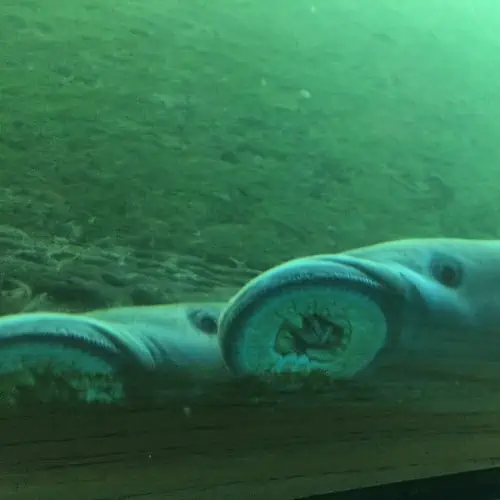
There are dozens of species of extant lampreys, and many of these are exceedingly successful at populating highly productive waters as parasitic fish. Remarkably similar in form to their ancestors, lampreys are ancient fish that have been around for 300+ million years. Distinctly jawless and worm-like in form, they are said to originate from ancestors that had already evolved to have an oral disk for sucking food.
If vampires had a lacustrine counterpart, lampreys would definitely be prime candidates. These blood-thirsty fish are able to latch onto the skin of larger, predatory species of game fish. Their suction capabilities are so developed that they can cling onto rocks as a means of staying put or moving forward in strong currents.
While lampreys are known for being carnivorous, a few species have evolved to maintain a vegetarian lifestyle. These non-carnivorous lampreys can supposedly persist on a diet of algae, though some researchers suspect that they may eventually re-develop a taste for meat. At first glance, a lamprey may easily be mistaken for an eel due to its elongated form and lack of fins. A closer look would reveal its unique gill pores, dorsal fin, and tooth-filled buccal cavity.
4) Sawfish (Pristidae)

The sawfish is perhaps one of the most easily identifiable prehistoric fishes due to its toothed rostrum, which is a natural extension of its skull. Seemingly straight out of a horror novel, this prehistoric fish looks much like a flattened shark. It can lie flat on the seabed as it has a smooth and unobstructed underside. Its characteristic “saw” is not actually attached to its mouth, which is located on the underside of its head.
Culturally significant in many coastal countries of the southern hemisphere, the sawfish has been used as a symbol of both masculinity and protection. The oldest fossils of its suspected ancestors are dated back to the Late Cretaceous period. With only 5 extant species, all of which are listed as either endangered or critically endangered, today’s living populations may be the very last of their kind.
Also known as carpenter sharks, sawfish are among the largest of all cartilaginous fish species. The largest specimens can grow to lengths of about 23 feet (7 meters). You can be certain that these fish use their saws, which can measure as much as 1/4 to 1/3 the length of their bodies, to stab and capture their prey. Luckily, they do not seek out humans as victims despite their presence as villainous creatures in age-old myths.
5) Coelacanth (Latimeria spp.)
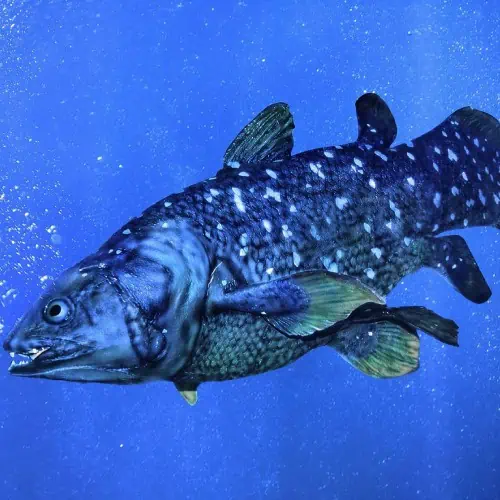
Once thought to be completely extinct, two species (L. chalumnae and L. menadoensis) of coelacanths made headlines in the 20th century for reappearing in coastal waters. These fish are extremely important in evolutionary history as they may be one of the missing links between fish and tetrapods. They possess a pair of pectoral fins that extend away from their bodies, much like legs. They are even able to move these fins alternately.
Coelacanths are incredibly difficult to find because they are deep-sea fish. There may be many more living specimens than the number that is actually suspected, or much less for that matter. With populations that supposedly remain at depths of around 2,300 feet (700 meters), they are as elusive as ever. They can also be quite aloof, preferring to withdraw whenever they come into close contact with their own kind.
Coelacanths have more unique characteristics that liken them to prehistoric fish. Instead of a backbone, for example, they have a notochord. This is a fluid-filled sac that precedes the occurrence of vertebra in the evolutionary timeline. Moreover, they have thick and dark scales that are quite common in extinct fish species. These lobe-finned fish can grow to an impressive length of around 7 feet (2 meters) and weigh as much as 198 pounds (90 kg) at maturity.
6) Dinosaur eels (Polypterus senegalus)
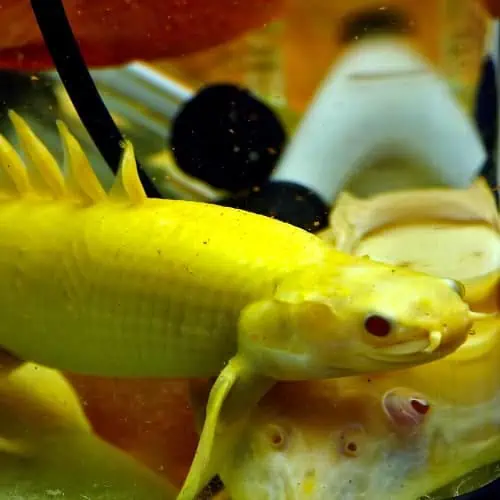
Neither a dinosaur nor an eel, the dinosaur eel is a stunning freshwater fish with economic value in the ornamental aquaculture industry. Frequently sought-after as a curiosity due to its primitive features, it can be readily bred in captivity as a bottom feeder. Mostly active during the day, this fish may appear to perch on the tank floor or swim actively as it socializes with its conspecifics. It is also commonly termed a “bichir”.
This elongated fish is an ambush predator, using suction feeding techniques to wolf down a wide variety of vertebrates, small crustaceans, and aquatic insects. As it is able to consume virtually any type of prey it can swallow, it should not be housed with valuable species of small fish. It is most comfortable in tanks where it has ample space to rest and hide.
The dinosaur eel is morphologically set apart by its external nostrils, which protrude from its rounded snout. Its large mouth gives it a seemingly calm and pleasant demeanor as its neutral position can be likened to a smile. Interestingly, it possesses primitive lungs which allow it to take in air and regulate its position in the water column. Lastly, its scales can be likened to its own body armor, effectively protecting it from abrasive surfaces and potential predators.
7) Alligator gar (Atractosteus spatula)
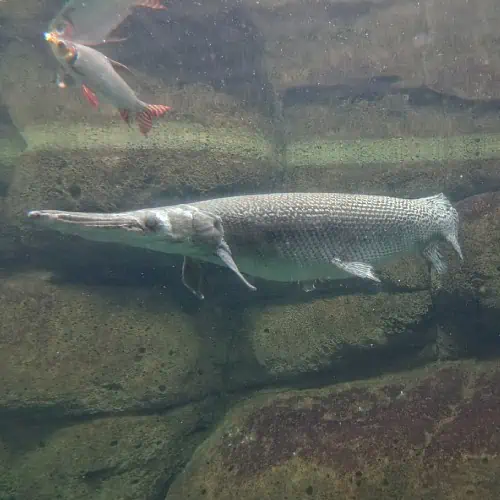
One of the largest freshwater fishes in the US, the alligator gar is a stunning creature with a wealth of commercial uses. This game fish can supposedly grow to a phenomenal length of 10 feet (3 meters), though most mature individuals measure at about 6 feet (1.8 meters) long. It is considered a prehistoric species as it belongs to a group of fish that first appeared during the Early Cretaceous period. It also possesses several features, such as armor-like scales, that are rarely seen in modern groups of fish.
As suggested by its common name, this intimidating fish has a broad snout and a jawline that looks very similar to that of an alligator. Even its rows of teeth, coupled with its heavy body and relatively flat head, contribute to its alligator-like physique. Present in reservoirs, lakes, and estuaries, a few populations may actually share their waters with their reptilian counterparts. Just like real alligators, they can even breathe air.
The alligator gar has another unique feature that is only found in primitive types of fish and in sharks – a spiral valve intestine. This corkscrew-like feature allows the fish to speed up its rate of intestinal absorption by increasing the surface area without lengthening the organ. This is also found in bichirs and lungfishes, which may likewise be considered prehistoric fish.
8) Frilled shark (Chlamydoselachus anguineus)

This shark is named for the fleshy and frill-like appearance of its gill filaments, which help protect its lengthy pairs of gill slits. Peculiar-looking and somewhat elusive due to its preference for feeding at night, the frilled shark has an elongated body shape, much like that of a large eel. It can easily measure as long as 6.5 feet (2 meters), is typically dark brown in color, and has jaws that are articulated to its cranium. Collectively, these features contribute to its status as a primitive species.
Frilled sharks usually remain close to the seafloor in zones that are highly productive. For this reason, they prefer to feed close to continental shelves and slopes. They largely live off of cephalopods that migrate to shallower waters at night. As they hunt, they are able to move stealthily and quickly, much like an eel. They trap their prey using rows of intricately curved teeth, after which they may swallow them whole.
The frilled shark’s fossilized ancestors date back to the Cretaceous period, during which they may have occupied shallower and inland bodies of water. These primitive sharks supposedly had larger teeth, which aided in their consumption of mollusks. In later periods, researchers suspect that other types of sharks may have outcompeted Chlamydoselachus, forcing it to occupy deeper parts of the ocean.
9) Arowana (Osteoglossinae)
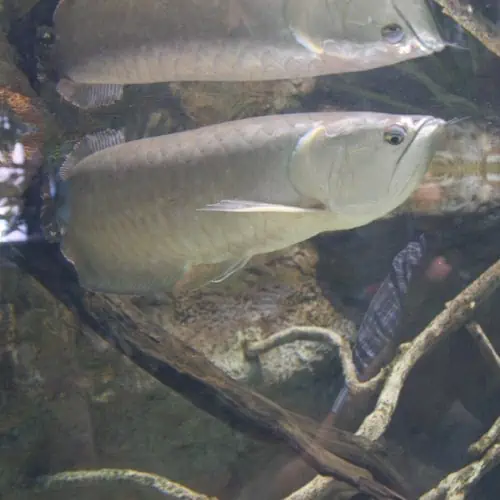
Extremely popular in the aquarium pet trade, the arowana is known for its stunning colors, intricately arranged and heavy scales, and impeccably soft, slender fins. This aggressive fish requires lots of space and care, and it should not be housed with much smaller species. As it can grow to about 3 feet (1 meter) long in an adequately-sized freshwater tank, rearing one requires commitment and a willingness to spend good money for its comfort.
Today’s extant arowanas are considered prehistoric fish because they diverged from primitive clades of Asian and Australian arowanas, with which they still share many traits. The fossils of these ancestral fish date as far back as the Middle Jurassic period, which took place about 170 million years ago. Their bony scales are remarkably heavy compared to those of most modern scaled fish groups. A single one can measure as wide as 2 cm, functioning as a key piece of their protective armor.
In the wild, arowanas prefer to inhabit blackwater rivers that are deeply stained by tannins from decaying vegetation. There, they feed on a wide variety of prey items on the water’s surface. Larger fish are even able to jump through the water’s surface and capture prey from overhanging branches. For this reason, they may sometimes be referred to as “water monkeys”.
10) Lancetfish (Alepisaurus spp.)
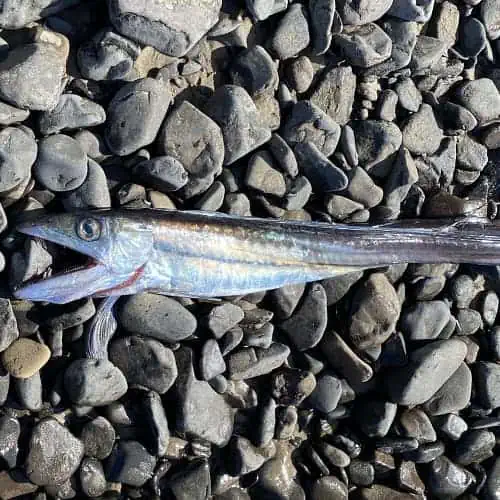
The genera name Alepisaurus is derived from a set of Greek words which collectively mean “scaleless lizard”. With their large mouths and markedly high dorsal fins, lancetfish do resemble some highly specialized types of desert reptiles. Their appearance can be somewhat bizarre to the untrained eye, especially if their fang-like teeth are exposed.
Lancetfish are unmistakable predators with an appetite for just about any adequately-sized living organisms in the water column. They are known for being excellent hunters, able to dash with impressive speed and accuracy in the presence of prey. Despite their widespread distribution, there remains many knowledge gaps in their biology.
With features that make them look as though they may have existed as far back as several hundred millennia, lancetfish continue to be a mystery of the deep seas. Today, there are only two (officially recognized) extant species of lancetfish that roam our oceans. These are the short-snouted lancetfish (A. brevirostris) and the long-snouted lancetfish (A. ferox).
11) Hagfish (Myxinidae)
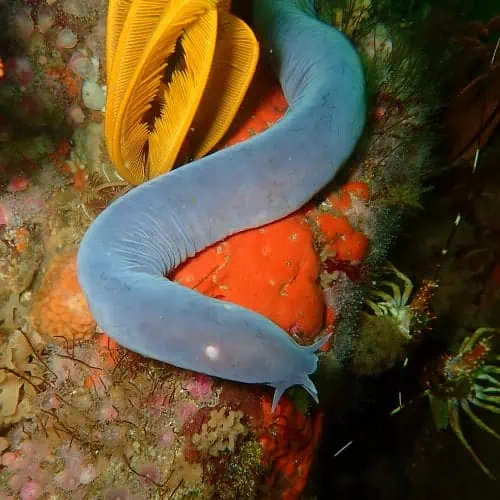
If you’ve ever seen a parasitic worm through the lens of a microscope, you might find that the hagfish looks like its oversized version. Also commonly referred to as slime eels, these infamous fish are often considered one of the most unappealing animals in the ocean. They are neither eels nor worms and are in fact a primitive type of vertebrae-less fish.
Hagfish have been around for about 300 million years. Today’s extant species may have subtle differences compared to their ancestors, which seemed to have actually had vertebrae. Extant hagfish have rudimentary vertebrae and a skull, so they are the only types of skulled fish without a columnar backbone. In terms of their external features, they may be likened to lampreys.
As a form of defense against potential predators, the hagfish can produce copious amounts of slime. It is an extremely important model organism in evolutionary biology as it reveals clues about how the vertebrate nervous system developed over time. Even its circulatory system is an anomaly among those of modern-day fish species. Its normal blood pressure is one of the lowest among all living fish species!


I’m trying to find a prehistoric-looking fish that my brothers pulled from the Missouri River in the 1960s. I don’t think we even took a pic. Thanks for sharing your work!
Hi Renee,
Thanks for your comment! Do you remember any details about the fish, such as its size, shape, color, or fins? Maybe it was one of the species mentioned in our blog post, or maybe it was something else. If you ever find a picture of it, I would love to see it!